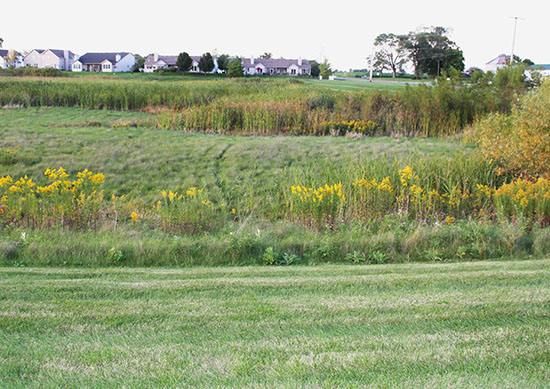Issue 17, September 28, 2015
Detention Ponds & WNV
Dry detention ponds are designed to contain excess water during rains and then drain out the water soon after. They are commonly used near housing developments and industrial buildings where building and parking areas replace rainfall absorptive soil areas with hard surfaces causing high water runoff during rainfalls.
Ideally, dry detention ponds completely drain of water soon after rains and are carpeted with turfgrasses that are mowed on a regular basis. Commonly, siltation and other vegetation change the characteristics of dry detention ponds, reducing their draining after rains and allowing moist soil or standing water to remain. These conditions inhibit normal mowing intervals. Emergent aquatic plants, such as common reed, Phragmites australis, and cattails, Typhia spp., are able to establish themselves in these habitats. These plants create conditions that tend to accumulate additional silt and debris, further reducing drainage.

Detention pond with emergent weeds.
West Nile Virus (WNV) is spread in Illinois primarily by two mosquito species. Culex restuans bites only birds and serves to vector WNV between birds. The northern house mosquito, Culex pipiens pipiens, bites both birds and mammals and vectors WNV between birds and mammals, including humans. These mosquitoes do not fly very far, typically flying a half mile or so from the stagnant water where they developed as larvae. In comparison, the very common eastern floodwater mosquito commonly flies 15 to 30 miles as an adult but does not carry WNV.
Research has shown that mowing common reed and cattails in detention basins increases the number of WNV carrying mosquitoes two-fold, about 200%. The Culex mosquitoes that vector WNV lay their eggs in stagnant water containing large amounts of rotting vegetation. They prefer the dark-colored, stinky water typically found in clogged gutters, tree holes, tin cans, old tires, and other pools of water containing decaying plant material such as mowed emergent aquatic weed debris in poorly draining detention basins.
An interesting twist is that these detention basins with common reed and cattails commonly contain primarily red-winged blackbirds, starlings, and purple grackles. These bird species are bitten by the Culex mosquito species carrying WNV, but they are poor reservoir hosts for WNV. In other words, mosquitoes that subsequently bite these birds do not transmit WNV to mammals and other birds very well. American robins are excellent reservoir hosts of WNV and are common in landscapes, but they don't tend to get close enough to the detention basins to be bitten by the homebody Culex mosquitoes there carrying WNV.
The take home message is that dry detention basins should be managed so that they drain soon after rains and do not contain standing water or damp soils. This allows the basin to support turfgrasses that can be maintained by mowing on a regular basis. The lack of proper basin management results in increased West Nile Virus carrying mosquitoes that are a threat to workers in the basin and somewhat to the people nearby.
Much of the above is based on the research conducted in central Illinois and is to be published by the Ecological Society of America as, Mackay, Andrew J., Ephantus J. Muturi, Michael P. Ward, and Brian F. Allan. Cascade of ecological consequences for West Nile virus transmission when aquatic macrophytes invade stormwater habitats. (Phil Nixon)
Author:
Phil Nixon